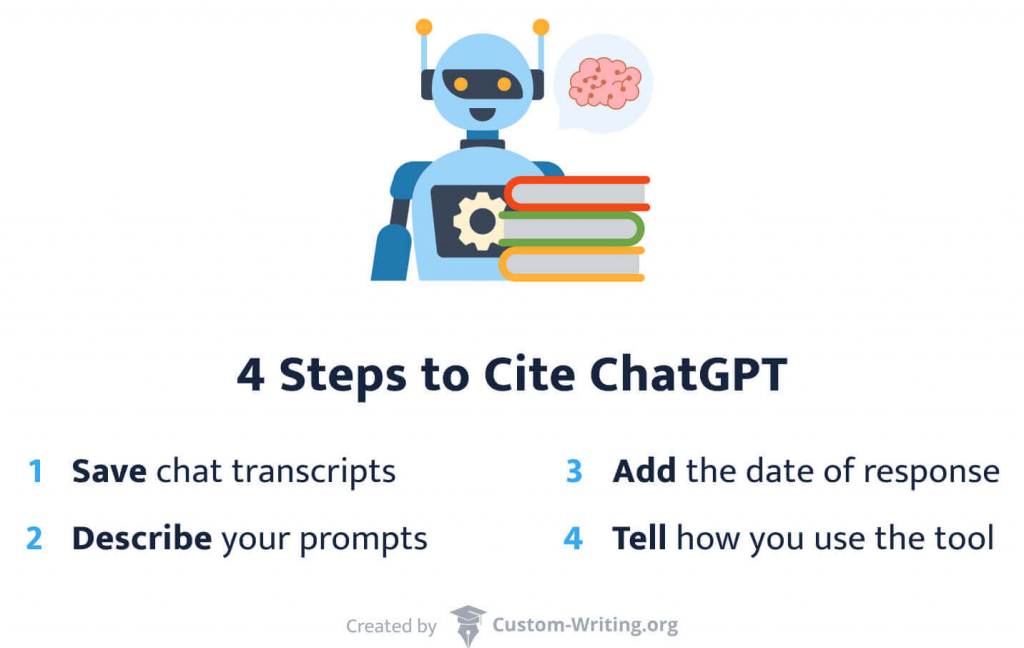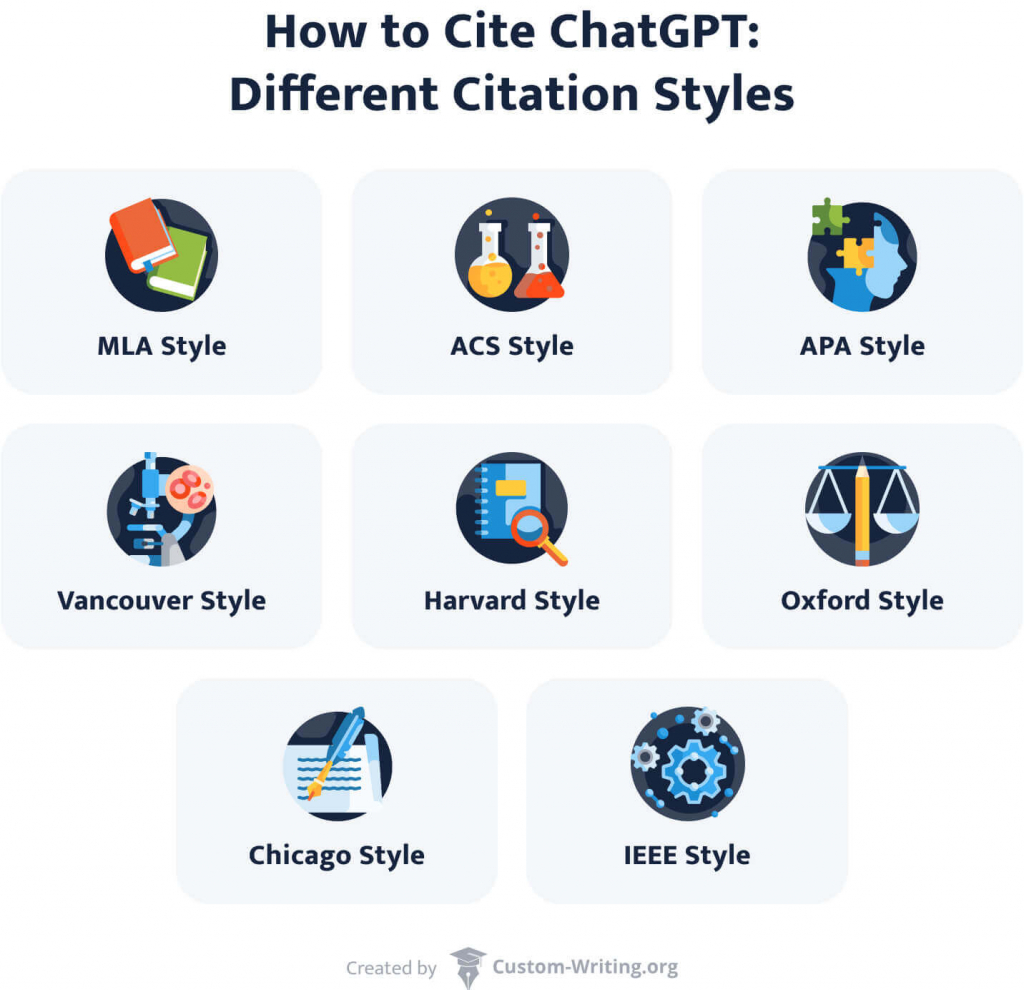As we delve into a new era of innovation, the scientific community comes face to face with the growing presence of artificial intelligence in the realm of college students. While the rapid accessibility of information may seem enticing, the reality is less ideal.
ChatGPT remains imperfect and can deliver inaccurate content. At the same time, discarding this resource seems counterproductive, as it is still a useful tool for research. Custom-Writing.org expert team developed this guide to provide proper citation instructions for AI in styles such as APA, Chicago, MLA, and others. Let’s find out how to cite ChatGPT content properly and why it’s essential.
📚 Why Is It Necessary to Cite ChatGPT?
In academia, proper citation enables students to reference external sources of information accurately. There are several different styles, including ACS, Harvard, Oxford, and MLA, that we’ll discuss later on. Such an approach to doing your assignment with ChatGPT is reliable and minimizes the risks to your academic success.

Students should learn how to cite Chat GPT sources they come across during the research for many reasons:
- Providing credible sources. This activity allows professors and others interested in the research to find the original study and check its credibility. Thus, it’s essential to verify the authenticity of the sources so that you’re not accused of irresponsible usage of ChatGPT.
- Showing due diligence. Giving credit to other researchers and scholars who previously worked on this topic demonstrates that you take academic assignments seriously and didn’t use fake citations in the work.
- Avoiding plagiarism. Having citations for outside works shows that you’ve conducted the research and didn’t try to pose provided facts, opinions, and other data as your own. Besides, don’t forget to use reliable AI detectors.
- Demonstrating your originality. Adding quotes to the work further demonstrates the uniqueness of student ideas and their origin in scientific research.
ChatGPT Citation & Responsibilities in Citing
There are several rules for quoting ChatGPT sources responsibly. They will help you use the AI chatbot ethically. Students should remember these steps to cite OpenAI’s solutions in their academic works properly:

- Save chat transcripts. When engaging with the AI chat, ensure that readers can access a copy of your conversation, either through an appendix or an online supplement.
- Describe your prompts. Always include the prompt used to elicit a specific response from the chatbot. This information will show the evaluators how well you’ve researched material with ChatGPT and formulated the request for a successful outcome.
- Add the date of response generation. As the tool has regular version updates, it’s essential to list the time and date when the answer was generated.
- Tell how you use the tool. Students should be transparent about using the platform in their research. Don’t forget this, even if you only asked the chatbot to make a paper outline. To be sure not to get into an unpleasant situation, we advise you to use an AI essay checker.
🔎 How to Cite Chat GPT: Different Citation Styles
Properly citing ChatGPT is imperative when using artificial intelligence in research. But, at this stage, you can face difficulties, as the chatbot doesn’t offer correct bibliographies. Everyone who writes an essay with a chatbot, a research paper, or an article can face such a struggle. To help students, we’ve gathered information about the most widespread citation styles and how to correctly quote ChatGPT in each of them.
Without further ado, let’s cover all the nuances.

MLA Style ChatGPT Citation
This style is popular among writers and students working on papers in English, literature, cultural studies, and other humanities disciplines. Guidelines for MLA citations recommend researchers cite the chatbot whenever paraphrasing, quoting, or referring to the generated content. Students should acknowledge what they used the tool for so they are not accused of AI cheating.
In the MLA format, it’s vital to check the sources quoted by the platform. In MLA, in-text ChatGPT quotes include reduced versions of the prompts used in quotation marks with parentheses. Begin with the text in quotes, then “ChatGPT,” its version, “OpenAI,” the date of the generated response, and its URL.
APA Style ChatGPT Citation
Researchers mostly use this style when writing papers on social sciences, such as sociology, psychology, and anthropology. The format was introduced by the American Psychological Association and requires more detailed citation rules for ChatGPT.
APA citation guidelines recommend mentioning how you used the chatbot in the method section or other appropriate parts. Provide the used prompt and a piece of the generated response. The full conversation can be added in the appendix.
In APA format, referring to the text generated by ChatGPT requires mentioning OpenAI and the year of the version used. Next, add [Large language model] and ChatGPT’s URL.
Harvard Style ChatGPT Citation
When referencing the AI chatbot under these guidelines, include the author’s name, publication year, title of the work, and the date of accessing the source. If you use direct quotes or paragraphs from ChatGPT, include the page or paragraph number where it can be found.
Chicago Style ChatGPT Citation
The Chicago citation style is widely used by publishers of academic journals and books. More specifically, for works regarding social sciences and humanities. Students use this style when writing history, religion, and social science papers.
In the Chicago manual, numbered footnotes list ChatGPT as the author, followed by the date of response generation. Next, one lists OpenAI as the publisher, with an optional URL. This style doesn’t advise students to add chat logs to the list of cited works. However, they should mention this whenever editing AI-generated content directly or at the end of the note.

Add the phrase “Text generated by ChatGPT, date of generation, “OpenAI,” and the general URL in the footnote when providing a prompt. When citing the same chatbot text multiple times, you can shorten the note to “ChatGPT.” Add a prompt to the footnote if it isn’t mentioned in the text. Finally, if you’re using author-date format instead of notes, put information not present in the text in parentheses.
ACS Style ChatGPT Citation
The American Chemical Society developed these niche guidelines. In the college environment, it’s used in academic papers on chemistry. While the ACS style doesn’t provide rules for citing AI-based texts, there are some suggestions you can use in your research assignments. Instead of citing ChatGPT as a data source, refer to it as a tool.
Vancouver Style ChatGPT Citation
The Vancouver style is popular in scientific research papers in the medical field. It uses a numerical approach that provides additional information about sources. These guidelines don’t offer concrete instructions for citing generative AI tools.
At the end of your text, list the ChatGPT source in the reference list, providing as much information as possible. This might include the title of the conversation, the date it was accessed, and the URL.
Oxford Style ChatGPT Citation
Oxford doesn’t directly tell how to cite Chat GPT content like many styles on this list. Students should use the same system for making footnotes in this style as other content types. The style has them add superscript numbers in the text and notes at the bottom of pages. The latter are numbered sequentially, starting with 1 and continuing throughout the paper. Direct quotes are enclosed with single quotation marks.
IEEE Style ChatGPT Citation
Students use these guidelines when working on papers in technology and engineering. Here, they must add the author’s name, the publication date, and the webpage URL. Use “n.d.” in the citations when there’s no publication date. This style has no special rules for citing ChatGPT and related generative AI products, so follow the general guidelines.
📜 Can ChatGPT Cite Sources?
Yes, but…
The free version of the OpenAI tool doesn’t have access to the Internet; it works with a restricted amount of data uploaded before January 2022, which messes with the responses. Such limitations cause ChatGPT to give wrong answers, which can be disastrous, especially in fields where new things are discovered daily.
Therefore, you risk obtaining incorrect sources whenever you ask the chatbot for references. The reason is simple: ChatGPT doesn’t address these sources itself; it can only provide the ones it was trained on.
Not having access to the Internet, ChatGPT can even make up some sources. The study about ChatGPT fabrications and citing errors shows that the tool produced over half of the fabricated citations (55%) for the GPT-3.5 and 18% for the GPT-4. At the same time, 43% of the authentic sources included substantive citation errors for the GPT-3.5 and 24% for the GPT-4.
Although it might seem that ChatGPT formulates truthful responses, we recommend checking all the resources the bot gives. After all, because of its limited access to information, it may hallucinate and give inaccurate answers to specific questions. Pay attention to these matters:
⚠️ Authenticity of sources. Double-check every article or other material in credible scientific databases, for example, Google Scholar, Web of Science, JSTOR, PubMed, and others.
⚠️Correctness of citations. Revise the citations provided by ChatGPT according to each style’s requirements. We recommend referring to the official guidelines or using the Free Reference Generator for Students.
However, if you want to avoid double work, there are AI chatbots that make thorough lists of used resources. Check them out in the next section.
🤖 Alternative AI-Powered Chatbots
The accelerated research of artificial intelligence introduced many chatbot models, each having unique capabilities and specialized features. Because ChatGPT has limitations regarding Internet access and citing sources, we’ve come up with several alternatives. Check them out, and you may find that they can serve as replacements for OpenAI’s chatbot.
- Bard
It’s a free multipurpose AI chatbot that generates text and voice responses. You can use it in over 40 languages, solve math problems, or generate images and code. Students use Bard to write and edit resumes, emails, bibliographies, and other text types. Bard is also linked to Google and lets users search for information and export it to Gmail and Google Docs. - Bing Chat
Microsoft’s tool is embedded into its Edge browser. It’s a free addition to the application that combines the top results of search requests to provide a detailed response. These answers include citations for all used sources. Bing chat also generates images based on user prints. Students can provide it with specific details to create outlines of their academic works or ask for help with the list of cited sources. - Perplexity
This free chatbot runs on OpenAI’s GPT-3.5 model. It will give you an easy way to get simple answers to your requests. Perplexity is a great way to research topics quickly and get links to the source material. Also, you can narrow down results from specific sources, save search threads, and share them.
Hopefully, you’ve found the proper quotation style and now know how to structure the bibliography and more. Share this guide with your friends who also struggle with this part of working on academic assignments. If you wish to learn more about ChatGPT capabilities, read our article about its usage for creating a brilliant essay.
Check out other excellent materials about ChatGPT and similar AI tools:
- Pros & Cons of ChatGPT for Students
- ChatGPT Essay Examples
- How to Use ChatGPT to Make a PowerPoint Presentation
- Can Chat GPT Proofread and Edit an Essay?
- 17 Best AI Tools for Students in 2026
- How Do AI Detectors Work?
- 17 Best AI Tools for Homework in 2026



